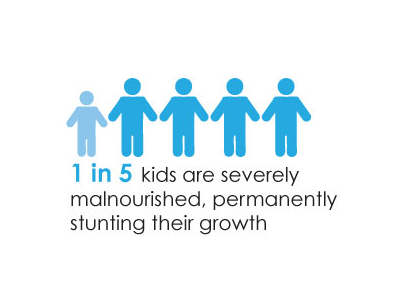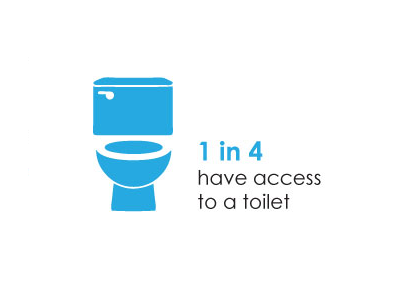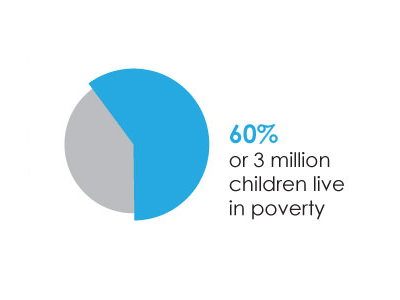Haiti, the Greatest Need
in the Western Hemisphere
Haiti is facing overlapping crises—hunger, violence, and mass displacement:
Hunger: About 5.7 million people (over half the country) are in acute food insecurity, among the worst worldwide.
Violence: 5,600+ people were killed in 2024, and armed groups control most of Port-au-Prince and nearby areas.
Displacement: ~1.3–1.6 million Haitians are uprooted—many from the capital region—with numbers hitting record highs in 2025.
Roads to the airport and seaports have been repeatedly cut by armed groups, driving up the cost—and difficulty—of basic supplies. Elections haven’t been held since 2016, and instability has deepened since the president’s 2021 assassination.
If you're interested in how this happened, watch this 6-minute video from The Guardian on How Haiti Came to be Run by Gangs.
Haiti is only 2 hours from Miami, yet is by far the poorest country in the western hemisphere with poverty and infrastructure on par with sub-Saharan Africa. After decades of corruption and natural disasters, 60% of Haiti and 3 million Haitian children live in extreme poverty. Most Haitian children are hungry and undereducated, and many have been abandoned. This is what life is like for Children in Haiti:
Why Is Haiti Such A Mess?
Haiti is the poorest country by far in the western hemisphere, and doing measurably worse compared than its Caribbean neighbors. Ever wonder why? Here’s a quick timeline of Haiti’s fascinating history.
Late 1700s
In the late 1700s, Haiti was France's most profitable colony, exporting 60% of all coffee and 40% of all sugar consumed in Europe. The French imported up to 40,000 slaves a year, accounting for more than 1/3 of the Atlantic slave trade at times. Conditions were atrocious and the life expectancy for these men and women was only 21.
1804
After a 13-year revolution with Napoleon's forces, Haiti became the the first slave colony to declare independence. For the next 20 years, Haiti was shunned and isolated by the international community, as countries like the US did not want their own slaves getting any ideas about a similar revolution.
1825
To open up international trade, Haiti was required to pay France the equivalent of $21 billion in reparations for "lost slaves." Haiti took out huge loans from American, German and French banks at exorbitant interest rates to cover it.
1900 - 1950
By 1900, Haiti spent 80% of its national budget on loan repayments. Haiti finally repaid the debt 120+ years later in 1947, leaving the country destitute and trapped in a spiral of debt. It got so bad, America occupied Haiti for nearly 20 years, terrified that they were about to default on their loans. During this US occupation, the US took control of the Haitian Treasury and banks and sent 40% of Haiti’s national income was sent to US and French Banks.
1950 - 1990
A series of domestic dictators followed, including the infamous Papa Doc and Baby Doc who killed 30,000 - 60,000 people as they embezzled hundreds of millions (best guesses are around $900 million). Both of these leaders were backed by the US for their strong anticommunist stance.
1990 - 1994
Haiti had its first democratic election in 1990, but 7 months later, then-President Aristide was overthrown, and death squads hunted down any of his supporters. Thousands died.
1994
Clinton sent 25,000 American troops to restore democracy, but American support was contingent on Haiti signing an agreement with the IMF and World Bank that bound them to open to foreign trade and required Haiti to import most of its food. Many rural agricultural workers were forced to migrate to the cities to look for work. This intervention by the US changed Haiti’s economy and workforce. As a result, Haiti does not have enough farmers to grown and supply its own food, greatly contributing to nearly half of the its population facing acute hunger (4.9 million Haitians).
2010
A 7.0-magnitude earthquake 16 miles off the coast of Haiti killed 220,000, injured 300,000 and displaced 1.5 million people and left $7.8 billion in damage.
Many of the displaced citizens still live in the temporary shacks that were set up, with no running water or sewers and no power. Foreign aid poured in, but corruption and incompetence by the government and the many aid organizations led to little progress. The American Red Cross took in half a billion dollars to rebuild 132,000 homes, but an NPR investigation 5 years later showed that only 6 homes had been rebuilt.
Additionally, sick UN peacekeepers from Nepal didn't properly handle their waste and contaminated the water source of a nearby displacement camp, starting the 9 year cholera epidemic in Haiti that left 10,000 dead and 800,000 infected.
2016
Haiti is smack dab in the Atlantic hurricane path and suffered another huge setback with Hurricane Matthew. The massive destruction led to the lost of up to 90% of crops and livestock in some areas. Poor construction, no coordinated system in place to manage disasters, and massive deforestation, some of which dates back to the French clearing the land for sugar plantations, leaves Haiti particularly vulnerable to natural disasters. The last elections were held in 2016.
2018 - 2019
Since 2018, Haiti has been plagued with civil unrest leading to country-wide protests that shut roads, businesses, schools and access to hospitals.
2018 - 2019
The last elected president was assassinated in July of 2021. To this day, nobody in Haiti has been tried for his assassination. There are currently no elected officials in Haiti. All terms from senators, to judges, to mayors have expired and there haven’t been any new elections to fill those seats. In August of 2021, Haiti suffered another earthquake that killed thousands.
Today
There are 200+ gangs in Haiti that are essentially running the country. They have taken over most of Port-au-Prince and spread into the surrounding areas. The gangs are often paid by politicians to do their bidding and they make their money by kidnapping, controlling the flow of goods in industries like shipping and transporation, and also by stealing food, fuel and water to sell on the black market. The UN is looking into options for an armed military force to work with the Haitian police to restore order.










